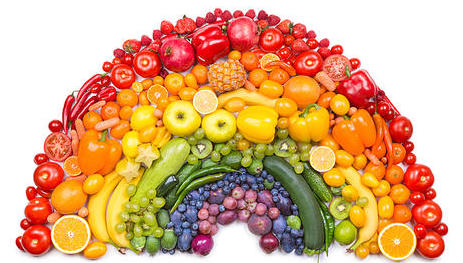Discover the health benefits of colorful foods like greens, reds, oranges, and purples. Learn how to incorporate these vibrant fruits and vegetables into your diet for better nutrition and wellness.
Here in New York City, we have had (too) many weeks in a row of freezing temperatures, falling snow, and fluffy winter coats; but, alas, today brings us the unofficial beginning of spring: Daylight Saving Time. We may have lost an hour of sleep, but we’ve gained back hope and optimism now that sunnier, longer, and warmer days are just around the corner. Is that the inspirational, motivational sound of a bird chirping in the distance telling me anything is possible? I think so!
Spring also brings with it a bigger and better variety of fresh, in-season produce*, which means it will be even easier to “eat the rainbow,” a great way to ensure you’re getting optimal nutrition in each meal. Every beautiful, bright pigment of a fruit or vegetable indicates what the plant is carrying on the inside. The technical term for these pigments and chemical compounds is phytochemicals which play a role outside the usual nutrients and vitamins by acting as antioxidants, protecting cells, and disabling cancer-causing substances. Instead of trying to remember the amount of servings of fruits and vegetables you should be getting each day, it might be easier to focus on color.

Blue or purple foods—think blueberries, plums, and eggplants—contain anthocyanin which supports a healthy heart, blood pressure, and circulation and offers anti-inflammatory benefits. The dark green colors found in broccoli, Brussels sprouts, and kale stem from chlorophyll, indoles, and isothiocyanates, which encourage the liver to remove any potential carcinogenic substances and may lower the risk of breast and prostate cancers. Lutein supports eye health, reduces the risk of cardiovascular disease, and is found in yellow-green-colored foods like kiwifruit, avocado, and pistachios, while lycopene found in red plant foods like tomatoes, watermelon, and cranberries promotes cancer protection and may lower both low-density lipoprotein (LDL or “bad”) cholesterol and total cholesterol. Red foods also boast flavonoids which carry anti-inflammatory and antioxidant properties and may help prevent coronary heart disease and cancer. Orange-yellow foods like carrots, pumpkins, apricots, and mangos contain beta-cryptoxanthin and beta-carotene, which convert in the body to vitamin A, another key component for healthy vision and immune function.
Consider the following:
- The next time you’re at the supermarket, let nature do the shopping for you. Allow your eye to fall on the most vibrant of fruits and vegetables in the produce section, then buy a mix of those.
- Before you eat a meal at home or take one with you to work, count your colors. Try to have at least three differently colored foods on your plate.
- Be adventurous. Add fruits and vegetables to dishes you normally might not, like strawberries to your salad, collard greens to your quinoa, or peas to your pasta.
Eating a variety of fruits and vegetables on a daily basis helps you create the right mix of nutrient profiles. When you stock your refrigerator regularly with colorful fruits and vegetables or have a plan to order these when eating out; you not only establish lifelong habits, but you also lower your chances of heart disease, cancer, and other chronic diseases.
*If you can’t find fresh produce, frozen or canned works fine, too. Just be sure to check the Nutrition Facts Label and ingredients list to avoid added sugar, salt, or fat.
References
- Major Phytochemicals: Recent Advances in Health Benefits and Extraction Method https://www.ncbi.nlm.nih.gov/pmc/articles/PMC9862941/
- Antioxidants https://www.hsph.harvard.edu/nutritionsource/antioxidants/
- The Importance of Healthy Dietary Patterns in Chronic Disease Prevention https://www.ncbi.nlm.nih.gov/pmc/articles/PMC6328339/



0 Comments